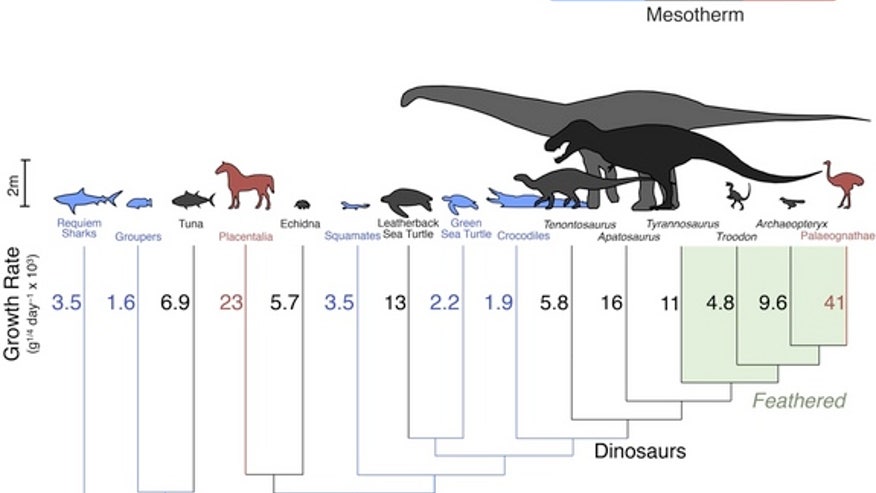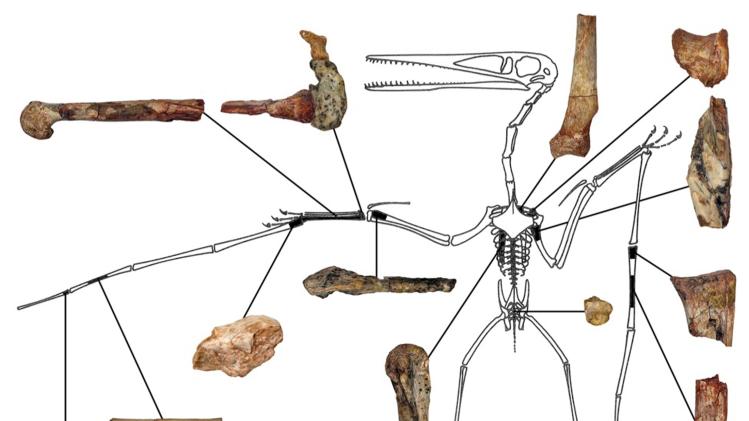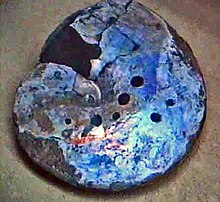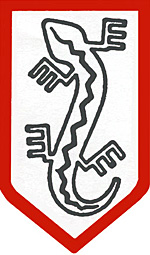Mosasaurs (from
Latin Mosa meaning the '
Meuse river', and
Greek σαύρος
sauros meaning 'lizard') are large, extinct,
marine reptiles. The first fossil remains were discovered in a limestone quarry at
Maastricht on the Meuse in 1764. Mosasaurs probably evolved from semiaquatic
squamates[1] known as
aigialosaurs, which were more similar in appearance to modern-day
monitor lizards, in the
Early Cretaceous. During the last 20 million years of the Cretaceous period (
Turonian-
Maastrichtian), with the extinction of the
ichthyosaurs and decline of
plesiosaurs, mosasaurs became the dominant marine predators.
Description

Tylosaurus proriger erroneously depicted with a dorsal crest and no tail fluke, by
Charles R. Knight, 1899
Mosasaurs breathed air, were powerful swimmers, and were well-adapted to living in the warm, shallow,
epicontinental seas prevalent during the Late Cretaceous Period. Mosasaurs were so well adapted to this environment that they
gave birth to live young, rather than return to the shore to lay eggs, as
sea turtles do.
The smallest-known mosasaur was
Carinodens belgicus, which was about 3.0 metres (9.8 ft) to 3.5 metres (11 ft) long and probably lived in shallow waters near shore, cracking
mollusks and
sea urchins with its bulbous teeth. Larger mosasaurs were more typical:
Hainosaurus holds the record for longest mosasaur, at 17.5 metres (57 ft).
Mosasaurs had a body shape similar to that of modern-day monitor
lizards (varanids), but were more elongated and streamlined for
swimming. Their limb bones were reduced in length and their paddles were
formed by webbing between their elongated digit-bones. Their tails were
broad, and supplied the locomotive power. This method of locomotion may
have been similar to that used by the
conger eel or
sea snakes
today. However, more recent evidence suggests many advanced mosasaurs
had large crescent-shaped flukes on the ends of their tails similar to
those of
sharks and
ichthyosaurs.
Rather than snake-like undulatory movement, their bodies probably
remained stiff in these mosasaurs to improve hydrodynamic efficiency
through the water, while the end of their tails provided strong
propulsion.
[2] The animal may have lurked and pounced rapidly and powerfully on passing prey, rather than hunting for it. A juvenile
Prognathodon
found in Jordan's Harrana Site in 2008 and described in 2013 supports
this, as the outline of its tail fluke was also preserved with the
skeleton.
[3]
Early reconstructions showed mosasaurs with dorsal crests running the
length of their bodies, which were based on misidentified tracheal
cartilage. When the error was discovered, depicting mosasaurs with such
crests was already a trend.
[4][5]
Paleobiology
Mosasaurs had double-hinged jaws and flexible skulls (much like that of a
snake),
which enabled them to gulp down their prey almost whole, a snake-like
habit which helped identify the unmasticated gut contents fossilized
within mosasaur skeletons. A skeleton of
Tylosaurus proriger from
South Dakota included remains of the diving
seabird Hesperornis, a marine
bony fish, a possible
shark, and another, smaller mosasaur (
Clidastes). Mosasaur bones have also been found with shark teeth embedded in them.
One of the food items of mosasaurs were ammonites, molluscs with shells similar to that of
Nautilus, which were very abundant in the Cretaceous seas. On fossil shells of some ammonites (mainly
Pachydiscus and
Placenticeras)
were found round holes, once interpreted as a result of limpets
attaching themselves to the ammonites. The triangular formation of the
holes, their size and shape, and their presence on both sides of the
shells, corresponding to the upper and lower jaws, is evidence of the
bite of medium-sized mosasaurs. It is not clear if this behaviour was
common across all size classes of mosasaurs.
Virtually all forms were active predators of fish and ammonites; a few, such as
Globidens, had blunt spherical teeth, specialized to crush mollusk shells. The smaller genera, such as
Platecarpus and
Dallasaurus,
which were about 1–6 m (10–20 ft) long, probably preyed on fish and
other small prey. The smaller mosasaurs may have spent some time in
fresh water, hunting for food. The larger mosasaurs, such as
Tylosaurus, and
Mosasaurus,
reached sizes of 10–15 m (33–49 ft) long, and were the apex predators
of the Late Cretaceous oceans, attacking other marine reptiles, in
addition to preying on large fish and ammonites.
Soft tissue
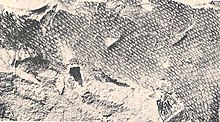
Scales of
Tylosaurus proriger (KUVP-1075)
Despite the relatively high number of mosasaur remains collected
worldwide, knowledge of the nature of their skin coverings remains in
its early stages. An incredibly small amount of mosasaurid specimens
collected from around the world retain fossilized scale imprints; this
lack of knowledge is possibly due to the delicate nature of the scales,
which nearly eliminates possibility of preservation, in addition to the
preservation sediments types and the marine conditions under which the
preservation occurred. Until the discovery of several mosasaur specimens
along with their remarkably well-preserved scale imprints from late
Maastrichtian deposits of the Muwaqqar Chalk Marl Formation of
Harrana[6] in
Jordan,
knowledge of the nature of mosasaur integument was mainly based on very
few accounts describing early mosasaur fossils dating back to the upper
Santonian-lower
Campanian, such as the famous
Tylosaurus specimen (KUVP-1075) from Cove County, Kansas.
[7]
Material from Jordan has shown that the bodies of mosasaurs, as well as
the membranes between their fingers and toes, were covered with small,
overlapping, diamond-shaped scales resembling those of snakes. Much like
modern reptiles, regional variations existed in the type and size of
the scales that covered the mosasaurs. In Harrana specimens, two types
of scales were observed on a single specimen,
[6]
keeled scales covering the upper regions of the body, as well as smooth
scales covering the lower regions. As ambush predators, lurking and
quickly capturing prey using stealth tactics,
[8] they are suggested to have benefited greatly from the nonreflective, keeled scales.
[6]
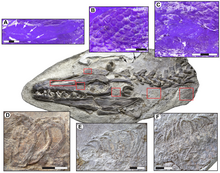
Soft tissues in the head and neck of
Platecarpus tympaniticus specimen LACM 128319: Tracheal rings are shown in the bottom three photographs.
More recently, a well-preserved fossil of
Platecarpus tympaniticus
has been found that preserved not only skin impressions, but also
internal organs. Several reddish areas in the fossil may represent the
heart, lungs, and kidneys. The trachea is also preserved, along with
part of what may be the
retina
in the eye. The placement of the kidneys is farther forward in the
abdomen than it is in monitor lizards, and is more similar to those of
cetaceans. As in cetaceans, the
bronchi
leading to the lungs run parallel to each other instead of splitting
apart from one another as in monitors and other terrestrial reptiles. In
mosasaurs, these features may be internal adaptations to fully marine
lifestyles.
[2]
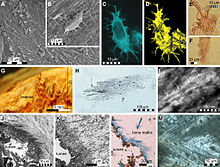
Fibrous tissues and microstructures recovered from
Prognathodon specimen IRSNB 1624
In 2011,
collagen protein was recovered from a
Prognathodon humerus dated to the
Cretaceous.
[9]
Environment
Sea levels were high during the Cretaceous period, causing marine transgressions in many parts of the world, and a
great inland seaway in what is now North America. Mosasaur
fossils have been found in the
Netherlands,
Belgium,
Denmark,
Portugal,
Sweden,
Spain,
France,
Germany,
Poland,
Bulgaria, the
United Kingdom,
[10][11] Russia,
Ukraine,
Kazakhstan,
Azerbaijan,
[12] Japan,
[13] Egypt,
Israel,
Jordan,
Syria,
[14] Turkey,
[15] Niger,
[16][17] Angola,
Morocco,
Australia,
New Zealand, and on
Vega Island off the coast of Antarctica. Tooth taxon
Globidens timorensis is known from the island of
Timor; however, the phylogenetic placement of this species is uncertain and it might not even be a mosasaur.
[18] Mosasaurs have been found in
Canada in
Manitoba and
Saskatchewan[19] and in much of the contiguous United States. Complete or partial specimens have been found in
Alabama,
Mississippi,
Tennessee, and
Georgia, as well as in states covered by the Cretaceous seaway:
Texas, southwest
Arkansas,
New Mexico,
Kansas,
[20] Colorado,
Nebraska,
South Dakota,
Montana, and the
Pierre Shale/
Fox Hills[disambiguation needed] formations of
North Dakota.
[21] Lastly, mosasaur bones and teeth are also known from
California,
Mexico,
Colombia,
[22] Brazil,
[14] Peru, and
Chile.
[23]
Many of the so-called 'dinosaur' remains found on
New Zealand are actually mosasaurs and
plesiosaurs, both being Mesozoic predatory marine reptiles.
Discovery

The
Mosasaurus hoffmannii skull found in Maastricht between 1770 and 1774
The first publicized discovery of a partial fossil mosasaur skull in
1764 by quarry workers in a subterranean gallery of a limestone quarry
in
Mount Saint Peter, near the Dutch city of
Maastricht, preceded any major dinosaur fossil discoveries, but remained little known. However, a second find of a partial skull drew the
Age of Enlightenment's
attention to the existence of fossilized animals that were different
from any known living creatures. When the specimen was discovered
between 1770 and 1774,
Johann Leonard Hoffmann,
a surgeon and fossil collector, corresponded about it with the most
influential scientists of his day, making the fossil famous. The
original owner, though, was Godding, a canon of Maastricht cathedral.
When the French
revolutionary forces
occupied Maastricht in 1794, the carefully hidden fossil was uncovered,
after a reward, it is said, of 600 bottles of wine, and transported to
Paris. After it had been earlier interpreted as a fish, a crocodile, and
a sperm whale, the first to understand its lizard affinities was the
Dutch scientist
Adriaan Gilles Camper in 1799. In 1808,
Georges Cuvier confirmed this conclusion, although
le Grand Animal fossile de Maëstricht was not actually named
Mosasaurus ('
Meuse reptile') until 1822 and not given its full species name,
Mosasaurus hoffmannii,
until 1829. Several sets of mosasaur remains, that had been discovered
earlier at Maastricht but were not identified as mosasaurs until the
19th century, have been on display in the
Teylers Museum,
Haarlem, procured from 1790.
The Maastricht
limestone
beds were rendered so famous by the Mosasaur discovery, they have given
their name to the final six-million-year epoch of the Cretaceous, the
Maastrichtian.
Evolutionary antecedents

Restoration of
Aigialosaurus bucchichi, a basal mosasaur
Based on features such as the double row of pterygoid ("flanged")
teeth on the palate, the loosely hinged jaw, modified/reduced limbs and
probable methods of locomotion, many researchers believe that
snakes share a common marine ancestry with mosasaurs, a suggestion advanced in 1869, by
Edward Drinker Cope, who coined the term "Pythonomorpha" to unite them. The idea lay dormant for more than a century, to be revived in the 1990s.
[25][26] Recently, the discovery of
Najash rionegrina, a fossorial snake from South America cast doubt on the marine origin hypothesis.
The skeleton of
Dallasaurus turneri,
described by Bell and Polcyn (2005), has a mixture of features present
in the skeletons of derived mosasaurs and in the skeletons of mosasaurid
ancestors such as aigialosaurids.
Dallasaurus retains
facultatively terrestrial limbs similar in their structure to the limbs
of aigialosaurids and terrestrial squamates (plesiopedal limb
condition), unlike derived mosasaurids which evolved paddle-like limbs
(hydropedal limb condition). However, the skeleton of
Dallasaurus
simultaneously had several characters that linked it with derived
members of the subfamily Mosasaurinae; the authors of its description
listed "invasion of the parietal by medial tongues from the frontal,
teeth with smooth medial enamel surface, high coronoid buttress on
surangular, interdigitate anterior scapulo-coracoid suture, humeral
postglenoid process, elongate atlas synapophysis, sharp anterodorsal
ridge on synapophyses, vertically oriented vertebral condyles, elongate
posterior thoracic vertebrae, and fused haemal arches" as the characters
uniting
Dallasaurus with Mosasaurinae.
[27]
The phylogenetic analysis conducted by Bell and Polcyn indicated that
hydropedal mosasaurids did not form a clade that wouldn't also include
plesiopedal taxa such as
Dallasaurus,
Yaguarasaurus,
Russellosaurus,
Tethysaurus,
Haasiasaurus and
Komensaurus
(in 2005 only informally known as "Trieste aigialosaur"); the analysis
indicated that hydropedal limb condition evolved independently in three
different groups of mosasaurs (Halisaurinae, Mosasaurinae and the group
containing the subfamilies Tylosaurinae and Plioplatecarpinae).
[27][28]
The result of this phylogenetic study was subsequently mostly confirmed
by the analyses conducted by Caldwell and Palci (2007) and Leblanc,
Caldwell and Bardet (2012);
[24][29]
the analysis conducted by Makádi, Caldwell and Ősi (2012) indicated
that hydropedal limb condition evolved independently in two group of
mosasaurs (in Mosasaurinae and in the clade containing Halisaurinae,
Tylosaurinae and Plioplatecarpinae).
[30] Conrad
et al. (2011), on the other hand, recovered hydropedal mosasaurs forming a clade that excluded their plesiopedal relatives.
[31]
If the hypothesis of Bell and Polcyn (2005) is correct, then mosasaurs
in the traditional sense of the word, i.e. "lizards that evolved
paddle-like limbs and radiated into aquatic environments in the late
Mesozoic, going extinct at the end of that era",
[28] are actually
polyphyletic; Bell and Polcyn (2005) maintained
monophyletic Mosasauridae by including
Dallasaurus and other aforementioned plesiopedal taxa in the family as well,
[27]
while Caldwell (2012) suggested (though explicitly stated that it was
not "a formal proposal of new nomenclature") to restrict Mosasauridae
only to the genus
Mosasaurus and its closest hydropedal relatives.
[28]
The exact phylogenetic position of the clade containing mosasaurids and their closest relatives (aigialosaurids and
dolichosaurs) within Squamata remains uncertain. Some
cladistic analyses recovered them as the closest relatives of snakes,
[32][33] taking into account similarities in jaw and skull anatomies;
[32] however, this has been disputed
[34][35][36] and the morphological analysis conducted by Conrad (2008) recovered them as
varanoids closely related to terrestrial
monitor lizards instead.
[34] Subsequent analysis of
anguimorph relationships conducted by Conrad
et al.
(2011) based on morphology alone recovered mosasaurids, aigialosaurids
and dolichosaurs as anguimorphs lying outside the least inclusive clade
containing monitor lizards and
helodermatids;
the analysis based on combined datasets of morphological and molecular
data, on the other hand, found them more closely related to monitor
lizards and the
earless monitor lizard than helodermatids and the
Chinese crocodile lizard were.
[31] The large morphological analysis conducted by Gauthier
et al. (2012) recovered mosasaurids, aigialosaurids and dolichosaurids in an unexpected position as basal members of the clade
Scincogekkonomorpha (containing all taxa sharing a more recent common ancestor with
Gekko gecko and
Scincus scincus than with
Iguana iguana[34]) that didn't belong to the clade
Scleroglossa.
The phylogenetic position of these taxa turned out to be highly
dependent on which taxa were included in or excluded from the analysis.
When mosasaurids were excluded from the analysis, dolichosaurs and
aigialosaurids were recovered within Scleroglossa, forming a
sister group to the clade containing snakes,
amphisbaenians,
dibamids and the
American legless lizard.
When mosasaurids were included in the analysis, and various taxa with
reduced or absent limbs other than snakes (such as dibamids or
amphisbaenians) were excluded, mosasaurids, aigialosaurids and
dolichosaurs were recovered inside Scleroglossa forming the sister group
to snakes.
[37]
Longrich, Bhullar and Gauthier (2012) conducted a morphological
analysis of squamate relationships using a modified version of the
matrix from the analysis of Gauthier
et al. (2012); they found
the phylogenetic position of the clade containing mosasaurs and their
closest relatives within Squamata to be highly unstable, with the clade
"variously being recovered outside Scleroglossa (as in Gauthier
et al., 2012) or alongside the limbless forms".
[38]
